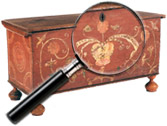|
|
Rolf Armstrong – American Artist, 1889 to 1960
Rolf Armstrong’s glowing portraits of gorgeous film stars and vivacious girls-next-door soon established him one of the best paid commercial artists in America. Often dubbed the “Father of Pinup Art,” his very first calendar pinup, created in 1919, set a new standard for the depiction of feminine charm for over forty years. Armstrong’s art is imbued with grace, vibrancy, and life, and as a result, his [...] Click here to continue reading.
John French Sloan (American, 1871 to 1951)
A student of the Pennsylvania Academy of Fine Arts, Sloan’s early artistic career was spent as an illustrator for local newspapers in Philadelphia. In 1904, he moved to New York where his many etchings and paintings of New York City, part of the Ash Can School, led to his considerable fame. “His posters display a firm control of graphic design that continued throughout his extensive career as [...] Click here to continue reading.
“The Eight” – Ashcan School
The Ashcan School was a realist artistic movement that came into prominence in the United States during the early 20th century, best known for works portraying scenes of daily life in New York’s poorer neighborhoods. In 1908, the Macbeth Gallery in New York mounted an independent exhibition of artists who became known as “The Eight,” consisting of Arthur B. Davies, Maurice Prendergast, Ernest Lawson, William Glackens, Everett Shinn, John [...] Click here to continue reading.
Nicolai Ivanovich Fechin (Russian, American, 1881 to 1955)
Nicolai Fechin was born in 1881 in the city of Kazan near the Volga River to a craftsman who gave his son his earliest instruction in drawing and sculpting. At fourteen, he enrolled at the Art School of Kazan, then studied at the Imperial Academy in St. Petersburg, from which he eventually graduated in 1908. In just a few years, the young artist attained international success, [...] Click here to continue reading.
Jack Butler Yeats, (Irish, 1871 to 1957)
Jack B. Yeats, described by T. G. Rosenthal as “Ireland’s greatest visual artist (The Art of Jack B. Yeats, London, 1993, page 1), was born in 1871, the son of John Butler Yeats (1839 to 1922), painter, illustrator, and in later life the drinking companion of the Ashcan School painter John Sloan and the American collector John Quinn. Jack Yeats’ older brother was the poet, William Butler [...] Click here to continue reading.
Catharine Carter Critcher (American, 1868 to 1964)
Born in Westmoreland County, Virginia in 1868, Catharine Critcher received her formal training at New York’s Cooper Union School as well as the Corcoran School of Art in Washington, D.C. By 1900 she began a successful career painting society portraits of elite Virginians. Like many artist’s of her generation, Critcher eventually traveled to Paris to attend courses at the Academie Julian in 1904. While in Paris, Critcher [...] Click here to continue reading.
Theodore Waddell (American, born 1941)
Both Montana rancher and artist, Theodore Waddell depicts the land and animals that he sees and works with on a daily basis. His work is striking evidence that the Art of the American West has evolved to include a very wide range of subjects, styles, and techniques. Waddell is a third generation Montanan who trained in the art academies far from his family roots only to return to first [...] Click here to continue reading.
Charles H. Chapin (American, 1830 to 1889, active New Orleans 1882-85),
Charles H. Chapin arrived in New Orleans from New York City in the winter of 1882, and advertised as a painter of portraits and landscapes, and as a teacher. Chapin had earned critical acclaim for his portrait of Polish actress Helena Modjeska in her role as Mary Queens of Scott. While in New Orleans, he established a studio on Dryades Street and exhibited [...] Click here to continue reading.
Carl Illig (American, New York, 1910 to 1987)
Carl Illig was born in 1910 in East Aurora, New York. Illig studied under Arthur Kowalski and was a student and colleague of Emile Gruppe during summers spent in Gloucester. Best known for Western New York landscapes and Gloucester harbor scenes, his work carried on a long tradition of Western New York landscape painters and recalls Carl Peters, Gruppe and others. In the late 1950s, he [...] Click here to continue reading.
Giovanni Maria delle Piane, called Mulinaretto (Italian, Genoa 1660 to 1745)
Giovanni Della Piane was one of the leading portraitists of the late Baroque in Italy, becoming court painter to the Farnese at their courts at Parma and Piacenza, and later to the Bourbons at Naples (no doubt due to the artist’s relationship with Elisabetta Farnese, the mother of Carlo VII of Naples, whom he had painted numerous times). He was trained in his [...] Click here to continue reading.
|
Recent Articles
- Charles Alfred Meurer – American Artist & Tromp L’Oeil Artist
- Sendak, Maurice – American Artist & Writer
- Godie, Lee – American Artist
- Davis, Vestie – American Artist
- Bartlett, Morton – American Artist
- Mackintosh, Dwight – American Artist
- Evans, Minnie Jones – African-American Artist
- Mumma, Ed (Mr. Eddy) – American Artist
- Nice, Don – American Artist
- Savitsky, John (Jack) – American Artist
- Gordon, Harold Theodore (Ted) – American Artist
- Dial, Thornton – African-American Artist
- Doyle Sam – American Artist
- Johnson, Lester Frederick – American Artist
- Finster, Howard – American Artist
|
|
